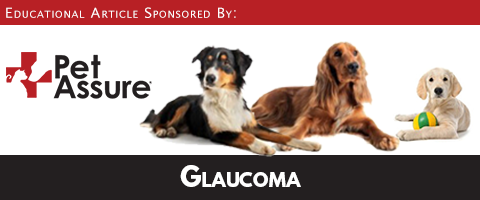A clear liquid produced by the eye maintains the shape of the eye. Extra liquid constantly drains from the eye. For the pressure within the eye to be healthy, the amount of fluid produced needs to be equal to the amount draining.
Glaucoma occurs when liquid does not drain properly, yet the eye keeps producing more. The pressure causes the eye to swell, which is painful and leads to blindness.
CAUSES:
There are two types of glaucoma:
- Primary Glaucoma: an inherited condition. Certain breeds are predisposed (Cocker Spaniels, Basset Hounds, Chow Chows, Shar Peis, and Labrador Retrievers).
- Secondary Glaucoma: another eye disease or injury causes the decreased fluid drainage. These include:
- Uveitis (inflammation inside the eye): scar tissue blocks drainage
- Cancer in the eye: the tumor block drainage
- Damage to the lens: proteins leak into the eye and blocks drainage
- Intra-ocular bleeding: a blood clot can form and block drainage
- Cataracts
SIGNS:
Glaucoma typically begins in one eye, but usually affects both eyes, leading to complete blindness. Some signs you should watch for:
- Eye pain: squinting and rubbing the eye
- Watery discharge
- Red eye
- Cloudy eye
- Swollen, bulging eye
- Vision loss
- Depression
If you notice any of the above signs, bring you dog to the veterinarian immediately. Glaucoma is extremely painful and can lead to blindness very quickly.
DIAGNOSIS:
Your veterinarian will determine if your dog has primary or secondary glaucoma because treatment and prognosis is different with each one.
Your veterinarian will do some of the following tests:
- Measurement of the intraocular pressure (IOP) with special instruments
- Evaluation of the drainage pathway with special instruments
- Ultrasound of the eye
- Corneal stain: your veterinarian will apply an orange stain to the cornea (outer layer of the eye), and wash off the excess. The left over stain sticks to any area where the surface is missing, and it turns green
TREATMENT:
Glaucoma needs difficult and expensive treatment for life. Treatment includes fixing any underlying issues, medication and surgery.
Medication: There are eye drops and pills that decrease fluid production or increase fluid drainage, both reducing pressure. However, medications are not a long-term solution. Most cases will end up requiring surgery.
Surgery: For dogs that still have vision, surgery will destroy the part of the eye that produces the liquid, and this may save the eye. For those that are already blind, surgery will remove the eye. Your veterinarian will either sew the skin shut, or put in a fake eye. Another option is to bypass the drainage area by putting a tube into the eye.
PREVENTION:
You cannot prevent glaucoma in your dog. To prevent relapse, see the listed treatment methods.
PROGNOSIS:
With medication only, most dogs with glaucoma with turn blind. With surgery, they may have their vision for longer.



